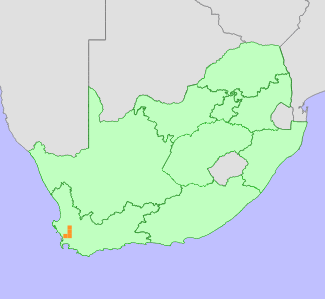|
Scientific Name | Serruria roxburghii R.Br. |
Higher Classification | Dicotyledons |
Family | PROTEACEAE |
Common Names | Short-leaf Spiderhead (e) |
National Status |
Status and Criteria | Endangered B1ab(ii,iii,iv,v)+2ab(ii,iii,iv,v) |
Assessment Date | 2020/06/30 |
Assessor(s) | A.G. Rebelo, H. Mtshali & L. von Staden |
Justification | The population of Serruria roxburghii has been fragmented due to extensive past habitat loss, mainly to crop cultivation and alien plant invasion, and it remains at four, possibly five locations within an extent of occurrence (EOO) of 732-769 km², and an area of occupancy (AOO) of 60-72 km². The population continues to decline due to ongoing habitat loss and degradation and this species is therefore listed as Endangered under criterion B. |
Distribution |
Endemism | South African endemic |
Provincial distribution | Western Cape |
Range | Serruria roxburghii has a limited distribution range in the Western Cape Province, South Africa, where it occurs from Riebeek Kasteel to Paarl. |
Habitat and Ecology |
Major system | Terrestrial |
Major habitats | Swartland Granite Renosterveld, Swartland Silcrete Renosterveld, Atlantis Sand Fynbos |
Description | It grows in deep sandy soils on flats, 60-200 m. Mature individuals are killed by fires, and only seeds survive. Seeds are released after ripening, and dispersed by ants to their underground nests, where they are protected from predation and fire. It is pollinated by insects. |
Threats |
| This species has already lost most of its habitat to agriculture (cereal cultivation, vineyards, pasture and chicken farms), urban expansion and sand mining. Only small, isolated remnants remain. These fragments are poorly managed, with livestock overgrazing, uncontrolled spread of alien invasive plants and inappropriate fire regimes causing ongoing degradation. Alien invasive plants, particularly acacias have a severe effect on depleting underground water resources and outcompeting native species. Groundwater abstraction for irrigation is also an ongoing and increasingly severe threat. |
Population |
A total of 13 subpopulations for four to five locations are known from a 30 km range. None of these are conserved. Five subpopulations are apparently extinct, in Paarl, Malmesbury, Riebeek West, Hermon and Vier en twintig riviere due to habitat loss to agricultural expansion. It is estimated that there are less than 10 000 plants. A continuing decline of population is inferred from ongoing habitat degradation.
|
Population trend | Decreasing |
Assessment History |
Taxon assessed |
Status and Criteria |
Citation/Red List version | | Serruria roxburghii R.Br. | EN A2c; B1ab(i,ii,iii,iv,v)+2ab(i,ii,iii,iv,v) | Raimondo et al. (2009) | | Serruria roxburghii R.Br. | Endangered | Hilton-Taylor (1996) | | Serruria roxburghii R.Br. | Endangered | Hall et al. (1980) | |
Bibliography |
Goldblatt, P. and Manning, J.C. 2000. Cape Plants: A conspectus of the Cape Flora of South Africa. Strelitzia 9. National Botanical Institute, Cape Town.
Hall, A.V., De Winter, M., De Winter, B. and Van Oosterhout, S.A.M. 1980. Threatened plants of southern Africa. South African National Scienctific Programmes Report 45. CSIR, Pretoria.
Hilton-Taylor, C. 1996. Red data list of southern African plants. Strelitzia 4. South African National Botanical Institute, Pretoria.
Manning, J.C. and Goldblatt, P. 2012. Plants of the Greater Cape Floristic Region 1: The Core Cape Flora. Strelitzia 29. South African National Biodiversity Institute, Pretoria.
Raimondo, D., von Staden, L., Foden, W., Victor, J.E., Helme, N.A., Turner, R.C., Kamundi, D.A. and Manyama, P.A. 2009. Red List of South African Plants. Strelitzia 25. South African National Biodiversity Institute, Pretoria.
Rebelo, T. 2001. Sasol Proteas: A field guide to the proteas of southern Africa. (2nd ed.). Fernwood Press, Vlaeberg, Cape Town.
|
Citation |
| Rebelo, A.G., Mtshali, H. & von Staden, L. 2020. Serruria roxburghii R.Br. National Assessment: Red List of South African Plants version . Accessed on 2025/05/31 |
 Comment on this assessment
Comment on this assessment

